- John Kealy
- Albums and Singles
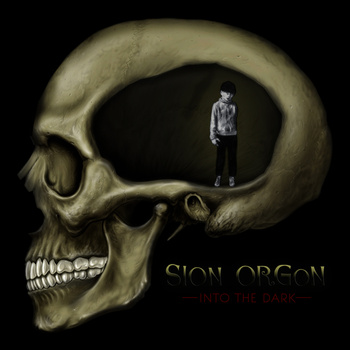 This short communication from Sion Orgon consists of a pair of very sweet tracks. Both feature Peter Christopherson but those looking for something that sounds like one of Sleazy’s projects will be left wanting as Orgon has made two great little pieces in his own image. Straddling weird lunar soundscapes and the less jittery side of prog rock, this single is brief, beautiful, and hopefully a portent of more to come.
This short communication from Sion Orgon consists of a pair of very sweet tracks. Both feature Peter Christopherson but those looking for something that sounds like one of Sleazy’s projects will be left wanting as Orgon has made two great little pieces in his own image. Straddling weird lunar soundscapes and the less jittery side of prog rock, this single is brief, beautiful, and hopefully a portent of more to come.
 
"Into the Dark" features, alongside Orgon and Christopherson (who contributed "manipulations and field recordings"), Thighpaulsandra and Seb Goldfinch, who bring shedloads of synthesisers and violin respectively.There is something off about the first half of the song (in a very good way). Orgon develops the piece with the sort of pacing that would leave a good horror director green with envy before the song bursts into a gorgeous vocal performance by Orgon; commanding yet human, it brings to mind some other Davids such as Bowie and Sylvian and it is absolutely mesmerizing.
On "Paper State" it is just Orgon and Christopherson’s field recordings (which are hard to discern). There is a melancholic edge to the music, a sadness that is just beyond memory but still leaves a phantom pain. In its few minutes of playing time, "Into the Dark" covers a remarkable scope without ever feeling like it has gone anywhere; its unassuming complexity is most impressive. Usually I find myself returning to 7" singles rarely as I am lazy and they require much more attention than an LP but between these two songs, I am drawn towards this little black disc more often than I would have anticipated.
 
Read More
- John Kealy
- Albums and Singles
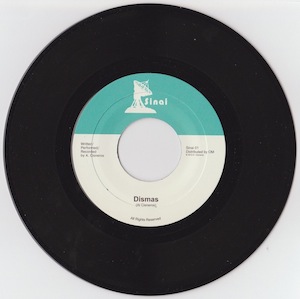 Al Cisneros, better known as the bassist and vocalist in Sleep and Om, has released a single reflecting his current obsession with dub. As it is self-released on his own new label, Sinai Records, this hopefully marks the beginning of another outlet for Cisneros on top of his already impressive CV. Even if it is only a one-off, “Dismas” is an unexpected and fascinating aside from Cisneros that complements his main work remarkably well.
Al Cisneros, better known as the bassist and vocalist in Sleep and Om, has released a single reflecting his current obsession with dub. As it is self-released on his own new label, Sinai Records, this hopefully marks the beginning of another outlet for Cisneros on top of his already impressive CV. Even if it is only a one-off, “Dismas” is an unexpected and fascinating aside from Cisneros that complements his main work remarkably well.
Sinai
While this is no exercise in genre hopping, "Dismas" certainly wears its influence on its sleeves mixing religious themes (the title of the song refers to the penitent thief crucified beside Christ at Golgotha) with a mix of Cisneros’s Raga, reggae and Middle Eastern bass playing style. With only a little rearrangement, this song would fit perfectly with Om’s current direction though in place of his own vocals he uses samples of a religious sermon or preacher.
Yet, the final result is something that sounds a little like the work his band mate Emil Amos, particularly his sample-heavy project Lilacs & Champagne. "Dismas" flows and does not outstay its welcome as if it was stretched out to a normal Om length, it would grow quite tiresome. Indeed, I would have preferred a different B-side as the second version of "Dismas" does not stray too far from the first version despite being slower and more sluggish.
 
Read More
- Administrator
- Albums and Singles
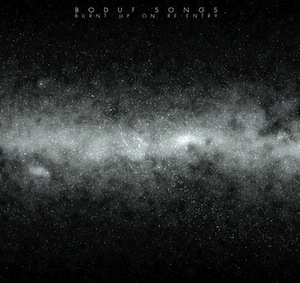 The follow up to last year’s EP Infernal Memo, Mat Sweet’s is first full length away from Kranky melds John Milton’s Paradise Lost with further developments in his writing and performing style. Moving further into musically (almost) upbeat territory while keeping the lyrics suitably bleak, Burnt Up On Re-Entry is another terrific addition to Sweet’s repertoire.
The follow up to last year’s EP Infernal Memo, Mat Sweet’s is first full length away from Kranky melds John Milton’s Paradise Lost with further developments in his writing and performing style. Moving further into musically (almost) upbeat territory while keeping the lyrics suitably bleak, Burnt Up On Re-Entry is another terrific addition to Sweet’s repertoire.
It might sound odd but the opening track, "Fiery the Angels Fell," is as indebted to mainstream "alternative" acts as it is to Sweet’s older nocturnal explorations. Drum machines, synths and chunky guitars create a constantly shifting background for the apocalyptic words which are sang with more clarity than on previous releases. This approach is a surprise but it works. The style is the template for the rest of Burnt Up On Re-Entry and overall this sounds like the great dark pop album of the '90s that was never made.
Yet just when I feel I know where the album is going, "Drexelius Sick Man Quarles Embemes Closed Heaven" shifts course altogether. Heavily processed vocals and Warp Records circa 1995 beats and soundscapes take me entirely off guard. It sounds brilliant both on its own and within the greater context of the album as it is a microcosm of some of the techniques used on other songs, forming a coherent but unexpected interlude during Burnt Up On Re-Entry.
While the overall style might be changing with every Boduf Songs album, what remains constant is the quality of Sweet’s lyrics and the heavy mood that covers the music like a shroud, no matter how accessible or tongue-in-cheek it might be.On the aforementioned "Fiery the Angels Fell," for example, Sweet mixes the lyrics to "It's Raining Men" with the ghastly imagery of people leaping from tall buildings to a wet, pulpy end. On the sublimely titled "Whither Thou Goest, Cretin," Sweet creates a basic, repetitive motif of a beat and bass line that should not sound so creepy for something that is so simple but it inexplicably sparks a panic. So many industrial, noise, or metal bands try to reach the same levels of bleakness and fail to come close to Sweet’s intonation of the mantra "Everyone Will Let You Down in the End" over a beautiful pair of guitar melodies. The song is already devastating before Sweet unleashes a huge sounding Sabbath-like riff to tip the whole thing over the edge.
Compared to albums like This Alone Above Else in Spite of Everything and How Shadows Chase the Balance, Burnt Up On Re-Entry does not quite reach the same despairing depths but it demonstrates that Sweet is unwilling to tread the same boards over and over again. Moreover, I feel that as well as being a good follow up to those frankly wonderful albums, this one has the capacity to find a larger audience for Boduf Songs. Whether that is a good or bad thing depends on a lot of factors. On one hand, I would love to see them live again but on the other, the fact that there is an almost cultish secrecy to Sweet’s music means that any dilution could destroy it.
samples:
- A Brilliant Shaft of Light from out of the Night Sky
- Whither Thou Goest, Cretin
- Everyone Will Let You Down in the End
 
Read More
- Administrator
- Albums and Singles
 After a decade-long hiatus, Aki Onda returns to his field recording series with a collage of recordings made during his first trip to Mexico back in 2005.  While the recordings themselves form a evocative and sometimes beautiful narrative, the surreality of Aki's travelogue is further enhanced by the fact that two of his three recorders began malfunctioning during the project.  As a result, South of the Border is occasionally bizarre enough to transcend the field recording genre and drift into relatively uncharted and unpredictable territory.
After a decade-long hiatus, Aki Onda returns to his field recording series with a collage of recordings made during his first trip to Mexico back in 2005.  While the recordings themselves form a evocative and sometimes beautiful narrative, the surreality of Aki's travelogue is further enhanced by the fact that two of his three recorders began malfunctioning during the project.  As a result, South of the Border is occasionally bizarre enough to transcend the field recording genre and drift into relatively uncharted and unpredictable territory.
South of the Border endearingly begins in what is quite possibly the least hip and experimental way possible, as "A Day of Pilgrimage" is essentially nothing more than a recording of a vaguely sad and out-of-tune-sounding marching band followed by a minute or so of muted, subtly distorted street noise.  Such an odd opening to the album definitely wrong-footed me, as it seems like there is nothing at all particularly artful about the piece: it is literally just a fairly lo-fi recording of a parade and nothing more.  Still, it had enough of ramshackle charm and mystery to it to make me want to keep listening, which turned out to be a good decision.
My gratification was not exactly instant, however, as the 9-minute piece that follows (the prosaically titled "Dust") seems to be just a largely untreated recording of a dust storm.  Fortunately, a few hints of something more begin to appear, as odd mechanical noises and an brief tape-distressed voice intrude upon the desolate-sounding low roar of the wind.  Thankfully, this quizzical effort finally blossoms about a third of the way through "Bruise and Bite," as the seemingly directionless hiss and crackle that opens the piece suddenly gives way to a very clear and haunting flute melody of some kind.
The transition caught me completely off-guard, as South of the Border immediately went from sounding like something harvested from Chris Watson's studio trash to something that sounds like a beatless Muslimgauze.  From that point onward, it became clear to me that while Aki's mental process may be entirely baffling to me, he is actually in complete control of what he is doing.  As the forlorn flute is joined by blurred and indecipherable human voices and a tortured-sounding counter-melody, "Bruise and Bite" evolves into something truly beautiful and moving.  Of course, it would have been nice if Onda's triumph was not bloated by its seemingly pointless four-minute introduction, but I suppose all of that unpromising hiss and clatter was necessary for the big surprise.
Happily, Onda's hot streak continues off and on for the rest of the album.  The unpromising marching band tenaciousnessly returns for "The Sun Clings to the Earth and There is No Darkness," but they are gradually drowned out by a rather distressed recording of a flock of birds that sounds sounds increasingly menacing and apocalyptic.  Then the album's lengthy final piece, "I Tell A Story of Bodies That Change," successfully reprises the droning-and-melancholy-flutes aesthetic of "Bruise and Bite."  It never comes anywhere near reproducing the aching beauty of its predecessor, but Aki gets significantly more ambitious with his collaging, so its 17 minutes follow a compelling unpredictable and subtly shifting trajectory.
Uncharacteristically, I have listened to this album several times without ever quite figuring out quite what Onda is trying to do or whether or not he may have succeeded.  I do know that Mexico is a very significant place for Aki, which stems from both a love of Alejandro Jodorowsky's El Topo and Aki's own childhood memories of his Olympian father's videos taken during the '68 Summer Olympics.  Consequently, I suspect that there is a lot of hidden meaning and emotion in these recordings that does not quite translate to me.  Still, my jaded ears were definitely struck by both "Bruise and Bite" and the subsequent bird attack. Otherwise, South of the Border remains something of an enigma for me, lying somewhere between "15 great minutes embedded in a sea of relative non-inspiration" and "a mysterious aesthetic too personal and unique for me to fully grasp."  Odds are, it is the former, but it is certainly an unusual and curiously ambiguous effort regardless.
- Bruise and Bite
- The Sun Clings To The Earth And There Is No Darkness
- I Tell A Story Of Bodies That Change
 
 
Read More
- Administrator
- Albums and Singles
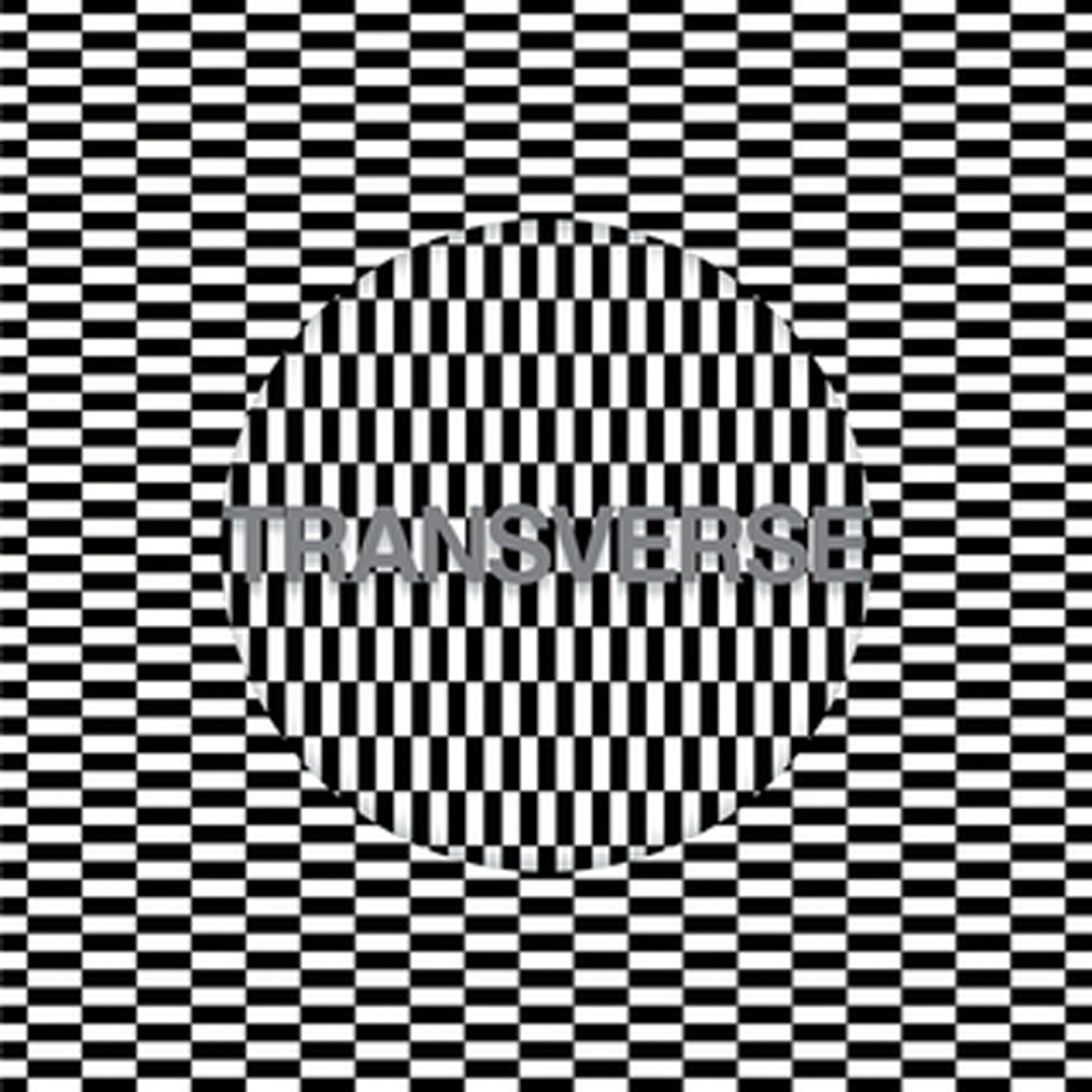 Back in 2011, Chris and Cosey united with Factory Floor's Nik Void (né Nikki Colk) for an improvised set during London's Short Circuit Festival.  Not very many people got to actually see it (it was a small room), but those lucky few who did were fairly unanimous in declaring it spectacular.  Thankfully, someone competently recorded it and everyone involved agreed that it should be released once they heard it.  I am sure that Transverse is not nearly as great as being there must have been, but it definitely makes for a very unexpected and satisfying consolation prize.
Back in 2011, Chris and Cosey united with Factory Floor's Nik Void (né Nikki Colk) for an improvised set during London's Short Circuit Festival.  Not very many people got to actually see it (it was a small room), but those lucky few who did were fairly unanimous in declaring it spectacular.  Thankfully, someone competently recorded it and everyone involved agreed that it should be released once they heard it.  I am sure that Transverse is not nearly as great as being there must have been, but it definitely makes for a very unexpected and satisfying consolation prize.
This album is an anomaly and an aberration in just about every possible way, as absolutely nothing about it is what I would have anticipated.  The biggest surprise is probably that it sounds absolutely nothing like recent Carter Tutti.  Instead, it resembles a bad-ass abstract hybrid between Throbbing Gristle and early '80s Chris & Cosey.  Part of that makes sense, as the beats and grooves were all harvested from unused Gristle recordings that Chris Carter had lying around.  The rest definitely does not though, as I do not understand why Chris & Cosey could not have made this album long ago or why they needed Ms. Void's involvement to make it happen.  I am not saying that Nik's contributions are not great (because they are great), but it is certainly bizarre that the involvement of someone in a very dancefloor-oriented band was what it took to steer Carter and Tutti into such ugly and noisy territory.  Transverse does not sound at all like the sum of its parts–it sounds like Chris & Cosey from 30 years ago in a particularly hostile mood.
Yet another twist is that the actual sounds themselves on Transverse are unexpected, as both Tutti and Void were wielding guitars for the performance.  While I know Colk used a bow and Cosey used a slide, there is very little here that recognizably sounds like guitar at all.  Instead, there is quite a lot of snarling, scraping, and shuddering and some sounds that seem like they could only emanate from a badly abused, detuned bass.  For his part, Chris Carter characteristically spent the show hunched over a table full of electronics.  It is nearly impossible to determine which sounds emanated from him and which came from the guitars for the most part, but the beats are definitely his and they are definitely great.  There is not much variation between these five pieces, as they all basically cohere into an endlessly throbbing and hypnotic whole periodically interrupted by well-earned cheering and clapping, but Carter's visceral, mechanized thumps and groans are both unrelenting and darkly sensual.
The final twist is that the music is quite regressive, but better for it.  None of these pieces approaches the complexity or craft of either Chris & Cosey's or Factory Floor's work, as the trio opt instead for simple rhythmic vamps with virtually no structural evolution or change.  There is not anything approaching an actual song at all, just a handful of killer early beats strafed with inspired eruptions of noise and the occasional wordless, digitized moan.  Normally, i would I expect such a one-dimensional attack to eventually get boring, but Transverse never does.  Nor does it ever get too cluttered or over the top.  In fact, it sounds like these three have been playing together forever, as everything unfolds organically and all of the spaces and flurries sounds like they are exactly where they need to be.
The only perfectly logical and predictable aspect of Transverse is that Void, Tutti, and Carter were able to work so well together, as Factory Floor occasionally shares a lot of common ground with Chris & Cosey's past work.There is not a lot of common ground with Gristle or with anything on this particular album, mind you, but it is evident that there is a lot of stylistic overlap and mutual admiration.  Even with that factored in, however, there is no denying that the chemistry between these three was absolutely perfect that night and that something truly unique and wonderful occurred.  That fact is highlighted by the final piece on the album, a studio version of "V4."  In theory, that should be the best piece, as it was professionally recorded and the trio had time to edit and re-record, but it somehow lacks the magic and energy of the four live pieces that precede it.  I have said many times that I do not understand the appeal of live albums at all, but Transverse is the exception to that rule: this album captures a performance that can probably never be replicated or topped.
Read More
- Administrator
- Albums and Singles
Kevin Drumm returns to Hospital with a double album of malign electronic ambient music. Drumm's subtle work with shifting, roving drones keep the pace and tempos moving with a Hitchcockian tension while details of a story emerge with swells and fades as other sequences are lost in the clatter of long chambers of isolation adorned with the trimmings of pagan beauties.
More information here.

Read More
- Administrator
- Albums and Singles
Scattered Melodies is a compilation of Korean Kayagum Sanjo Music. Sanjo, meaning "scattered melodies," is a form of stylized string improvisation developed in the 1890s originally for the Korean kayagum, a smaller distant cousin of the Japanese koto. Stark and haunting, falling in the gaps between folk and classical music, kayagum sanjo employs a gradually increasing tempo, focused improvisation (the "scattering of melodies"), elastic rhythms, and intense snaps and vibrato that seem to power through the hazy abstractions of the 78rpm recording technology (these are old, exceedingly rare records that have survived nearly insurmountable odds: invasion, occupation, war, division.). Presented here are a few of the masters of sanjo as it originally emerged in the early part of the 20th century on 78rpm recordings from 1925 to the early 1950s. This limited edition LP comes enclosed in a beautiful tip-on jacket with two-sided insert featuring extended liner notes by compiler Robert Millis.
More information here.

Read More
- Administrator
- Albums and Singles
The Crying Princess compiles rare Burmese 78rpm records gathered by Robert Millis and Sublime Frequencies co-founder Alan Bishop during various trips to Burma (Myanmar) and continues the tradition of amazing music from this Southeast Asian nation released by SF (Princess Nicotine, Guitars From the Golden Triangle, Music of Nat Pwe). Spanning the years 1909 to 1960 these unique and ridiculously rare records feature early sides by Po Sein (one of the giants of early Burmese music and theater), vocal and harp music from 1929, "modern songs with electric guitar," and unique Burmese pop songs with piano, all from 78rpm sources. This limited edition LP comes enclosed in a beautiful tip-on jacket with two-sided insert featuring liner notes by compiler Robert Millis.
More information here.

Read More
- Administrator
- Albums and Singles
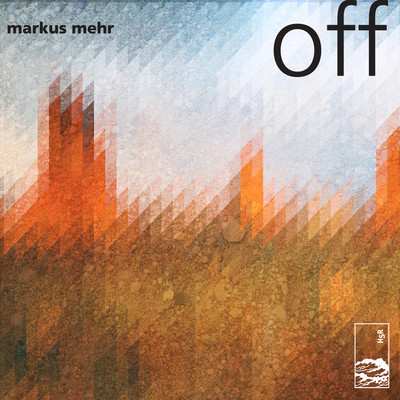 Markus Mehr is often compared to and grouped in with ambient composers like Tim Hecker and Fennesz for his use of timbre, bass, and unusual sound sources. But his collected works—In, On, Lava, Hubble, and now, Off—display an artistry and forethought that are more unique than he gets credit for. He recognizes the power and emotion that can be conjured from a focused process and an immaculately dense sound. But he came to that conclusion independently, not as an imitator.
Markus Mehr is often compared to and grouped in with ambient composers like Tim Hecker and Fennesz for his use of timbre, bass, and unusual sound sources. But his collected works—In, On, Lava, Hubble, and now, Off—display an artistry and forethought that are more unique than he gets credit for. He recognizes the power and emotion that can be conjured from a focused process and an immaculately dense sound. But he came to that conclusion independently, not as an imitator.
Off builds in intensity slowly over the course of its 42 minutes. Mostly, this consists of a steady drone of white noise and menacing bass rumbles. Above that, there are piano chords, hissing synths and non-sequitur electronic noise scattered around. I am always drawn to the contrasts of light and dark that seem inherent; the frigid atmospheres and distant whirrs, where subtle textures leave me unsettled and the pleasant moments stay grounded by their dissonant counterparts.
At the halfway mark, Mehr abandons a cacophony of wind and buzzing that has built up, leaving the piano and whirling drones alone for a few brief seconds. It feels like emerging from a tunnel only to find that I am driving into the path of a tornado. As it builds up into a storm of guitar feedback and reverb, I have forgotten about where the piece has begun, entranced instead by a tonal shift into some kind of hellish union of choir voices and endless noise. This slips in and out of focus as Off continues to evolve, often resolving nicely but easily tempted to return to a strange abyss.
Markus Mehr has crafted a sharply clever piece of music. It a evokes a presence that is rarely found; a balance between the ugly and the pretty where both can exist at once. I continue to be impressed by what Mehr is capable of.
Read More
- Duncan Edwards
- Albums and Singles
 These seven lengthy grooves are sure to please disco fans and their refreshing quality can be appreciated by those others who, like me, tend to view the genre with a mixture of amusement and terror. Sadly, behind the ecstatic sounds of 24 Hours in a Disco is the tale of a talented artist who was cursed by addiction and doomed by fame.
These seven lengthy grooves are sure to please disco fans and their refreshing quality can be appreciated by those others who, like me, tend to view the genre with a mixture of amusement and terror. Sadly, behind the ecstatic sounds of 24 Hours in a Disco is the tale of a talented artist who was cursed by addiction and doomed by fame.
Kiki Gyan was a high school dropout who became a millionaire before he was eighteen. Acclaimed for his solo and session work, he toured with Osibisa, performed for the Queen of England, and island-hopped on "champagne-soaked luxury liners." Gyan’s wealth frittered away and his years of drug abuse even led to psychiatric care. He was discovered dead, after 30 minutes on a toilet, an hour shy of his 47th birthday.
On record, though, the beat will always go on. As with Kraftwerk and others, incremental changes can seem huge in the course of a long song. Gyan's tunes have unrelenting pace and pure narrow vision which kept me feeling sharp on a long late-night drive recently, although several times my speed crept up rather high! Sound and rhythm indeed have the power to hypnotize: blinding us to the dangers of speed traps and much worse!
Read More
- Administrator
- Albums and Singles
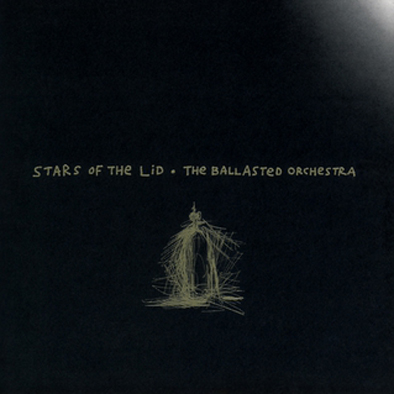 This recently reissued epic from 1996 was one of Stars of the Lid's first major statements, but it is not without its flaws, as Adam Wiltzie and Brian McBride were still at a stage in which their ambient influences were readily apparent.  Despite the occasional lack of distinctiveness, this remains a solid effort and benefits from a darkness and tension that is often absent from their more recent works.  More importantly, The Ballasted Orchestra contains the two-part "Music for Twin Peaks, Episode #30," which is a serious contender for the most perfect 20-minutes of music that Stars of the Lid ever recorded.
This recently reissued epic from 1996 was one of Stars of the Lid's first major statements, but it is not without its flaws, as Adam Wiltzie and Brian McBride were still at a stage in which their ambient influences were readily apparent.  Despite the occasional lack of distinctiveness, this remains a solid effort and benefits from a darkness and tension that is often absent from their more recent works.  More importantly, The Ballasted Orchestra contains the two-part "Music for Twin Peaks, Episode #30," which is a serious contender for the most perfect 20-minutes of music that Stars of the Lid ever recorded.
This double-album was Stars of Lid's first recording for Kranky, as the first two were originally on Sedimental.  Much like its predecessor, Gravitational Pull vs. The Desire for Aquatic Life, its a bit of a transitional effort: Wiltzie and McBride continued to distance themselves from the noisier and sample-centric aspects of their early work, but the warmer, more pristine and orchestral sound that they ultimately became known for had yet to quite take shape.  As a result, SOTL take some curious stylistic turns with The Ballasted Orchestra .  In particular, the cold and cavernous opening, "Central Texas," shares quite a bit more common ground with Lustmord or Steve Roach's The Magnificent Void than with late-period SOTL.Once the duo segues into the lengthier "Sun Drugs," the sound becomes more normalized, as they form a blurred and queasy haze through the work of some recognizable guitars.  In fact, "Sun Drugs" turned out to be a very clear precursor of what was ultimately to come from the duo, as it displays almost superhuman restraint, floating and undulating in near-stasis until it swells to a warmly humming and languorous crescendo of sorts.
The very brief "Down II," on the other hand, fleetingly returns to the days of Music for Nitrous Oxide, combining simple backwards guitar with hiss-heavy samples and chattering voices.  With the following "Taphead," however, the album begins to cohere into something special, as the duo combine hallucinatory, vaguely dissonant swells of guitar with menacing dark ambient rumble and hiss to forge a rather nightmarish foray into deep space.  It is certainly a likable piece, but the three songs that follow it begin to approach perfection, beginning with "Fucked Up (3:57AM)." Curiously, the piece seems almost like a warmer, less space-y reprise of "Taphead," but with all of the non-distinctively Star of the Lid elements removed to leave only gently swaying, glacially evolving audio heaven.
The first part of "Music for Twin Peaks Episode #30" (no such episode exists, incidentally) is even better still and is my own personal favorite Stars of the Lid piece of all-time.  Much like "Fucked Up," it is built upon endlessly repeating guitar swells, but all traces of dissonance are gone: it is just 8 perfect minutes of warm, lush chords billowing up from a bed of buzzing drone.  The second part is radically different, but no less stunning and makes the album's strongest case for Wiltzie and McBride being significantly more than just two guys that make great ambient/minimal neo-classical music.  Notably, there is hardly any conventional music to be found at all in it, as it is almost entirely based upon hiss and quiet guitar noise.  The magic lies in the fact that that hiss and guitar noise manages to maintain a deliciously simmering tension for over 13-minutes, a feat that it accomplishes so beautifully that even a single picked note seems powerful and meaningful in its midst.
The Ballasted Orchestra winds down with its longest piece, the 18-minute "The Artificial Pine Arch Song," but the album is essentially over for me after the second half of "Music for Twin Peaks."  "Pine Arch" serves an important purpose sequence-wise though: even though it is too edgeless and pastoral to interest me much, it provides a necessary come-down after the tension of the previous piece.  The album would feel weirdly truncated and unresolved if it did not exist, but it is not anything particularly special when decontextualized from its role as the album's dénouement.
Notably, the current reissue as a double LP differs slightly from both the original double-LP and the CD versions of the album.  For one, it restores the 6-minute "24 Inch Cymbal" that is absent from the CD/digital version.Also, the new reissue omits the brief untitled piece that originally concluded the first vinyl version.  I suspect that all of that is only of interest to completists though, as the three-song stretch of "Fucked Up" and "Twin Peaks" essentially eclipses the entire rest of the album.  The Ballasted Orchestra is certainly a fine effort and ranks among Stars' better works, but only "Music for Twin Peaks" is truly vital, absolutely-do-not-miss listening.
 
 
Read More

